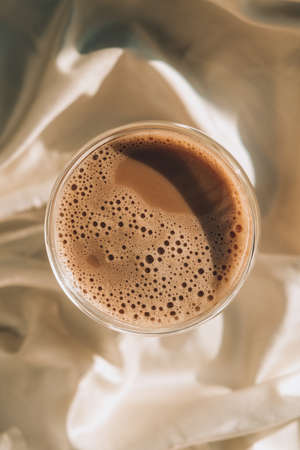1. Introduction: Chilling with Cold Brew—Indian Style
Step into any bustling café in Mumbai, Bengaluru, or Delhi during the relentless Indian summer, and you’ll spot glasses of cold brew glistening like monsoon rain on a windowpane. Once the realm of filter kaapi and chai, India’s café culture is evolving, embracing global trends while infusing them with local flair. The rise of cold brew and its effervescent cousin, nitro coffee, has swept across metros, offering relief from the heat and a new canvas for creativity. These chilled brews are more than just a trend—they’re a testament to how Indian palates are expanding, seeking out smoother, less acidic sips that pair perfectly with our rich heritage of milk and dairy alternatives. As we explore the best companions for your cold brew—from creamy buffalo milk to innovative plant-based options—let’s dive into how India is making this cool coffee wave uniquely its own.
2. The Indian Palette: Desires and Dietary Needs
India’s relationship with milk is as rich and layered as a cup of cold brew itself. Yet, the Indian coffee scene is rapidly evolving, fuelled by changing lifestyles, health awareness, and global influences. Let’s swirl our spoons into what’s stirring this transformation—why more Indians are choosing milk and dairy alternatives for their beloved cold brew and nitro coffee experiences.
Lactose Intolerance: Quietly Ubiquitous
Though milk is woven into the fabric of Indian cuisine, it’s estimated that over 60% of Indians experience some level of lactose intolerance. Symptoms like bloating or discomfort after dairy consumption are more common than openly discussed. As cold brew cafes pop up from Mumbai to Bangalore, many customers are seeking options that let them enjoy their iced coffees without side effects.
Veganism on the Rise
The vegan movement in India is picking up steam—fueled by ethics, environment, and health. Younger generations in metros like Delhi and Pune are increasingly experimenting with plant-based diets. Cold brew culture fits naturally into this lifestyle shift, making non-dairy milks an essential menu staple.
Ayurveda & Holistic Choices
Ayurvedic wisdom has long guided Indian food choices. For some, dairy can be “heaty” or aggravate certain doshas (body types), while nut milks or coconut milk are viewed as cooling and calming—perfect companions to the smooth bitterness of a cold brew.
Regional Tastes: Diversity in Every Cup
India’s culinary landscape changes every few hundred kilometers. While Punjab might favour creamy, high-fat buffalo milk, the coasts lean towards coconut and cashew. Here’s a quick look at how preferences differ:
| Region | Traditional Milk Choice | Popular Dairy Alternative |
|---|---|---|
| North India | Buffalo/Cow Milk | Soy Milk, Almond Milk |
| South India | Cow Milk | Coconut Milk, Cashew Milk |
| West India | Cow/Buffalo Milk | Oat Milk, Soya Milk |
| East India | Cow Milk | Coconut Milk, Rice Milk |
The Modern Café: Customization is King
Todays Indian coffee drinker wants choice—be it a vegan oat-milk nitro or a lactose-free almond cold brew. Coffee shops are responding with menus that respect both tradition and modern needs, ensuring everyone finds their perfect pour.
A New Era of Coffee Culture
The move toward milk alternatives isn’t just a trend—it’s about embracing diversity and wellness in every chilled sip. As India explores these new flavors, each glass of cold brew becomes a little more inclusive and infinitely more exciting.
![]()
3. Traditional Dairy Staples: Beyond the Doodh
In the Indian coffee scene, doodh – the Hindi word for milk – is more than just a household staple; it’s a canvas for regional diversity and age-old traditions. When crafting cold brew or nitro coffee, the choice of dairy can significantly influence the texture, taste, and aroma of your cup. Let’s journey through India’s beloved dairy options and see how they pair with these modern brewing techniques.
Buffalo Milk: The Creamy Classic
For many Indians, buffalo milk is synonymous with richness. Its high fat content gives cold brew a velvety mouthfeel and an indulgent creamy layer when poured over ice or charged with nitrogen. The boldness of buffalo milk stands up well to robust cold brews, creating a luscious harmony that’s perfect for those who crave decadence in their glass.
Cow Milk: The Balanced All-Rounder
Cow milk, widely consumed across urban and rural India alike, brings a lighter touch to cold brew. Its slightly sweet undertones and lower fat content allow the nuanced notes of specialty beans to shine through while providing enough creaminess to round out the edges. In nitro coffee, cow milk creates a smooth yet airy froth, ideal for those who prefer balance over intensity.
Camel & Goat Milk: Regional Gems with Distinctive Notes
Venture into Rajasthan or parts of Gujarat and you’ll find camel milk making its mark in local kitchens. Slightly salty and uniquely mineral-rich, camel milk lends an earthy complexity to cold brew—a true conversation starter for adventurous palates. Meanwhile, goat milk, popular in Himalayan regions, offers a tangy flavor profile that pairs intriguingly with chocolatey or fruity beans. Both are less conventional but open up new frontiers for experimental coffee drinkers seeking India’s lesser-known terroirs in their cups.
Milk Matters: Choosing What Suits Your Sip
Ultimately, each traditional dairy option brings its own story and character to cold brew and nitro coffee. Whether you lean towards the creamy luxury of buffalo milk or the subtlety of cow milk—or dare to try camel or goat for a regional twist—embracing these staples allows you to enjoy your cold coffee as uniquely Indian as it gets.
4. New-Age Alternatives: Plant-based Picks for Desi Coffee Lovers
As India’s coffee culture blossoms, the rise of plant-based milks is reshaping the way we enjoy our cold brew and nitro concoctions. From Bengaluru’s chic cafes to Mumbai’s artsy hideouts, “alt-milks” are no longer just a global fad—they’re becoming a staple for desi coffee lovers seeking healthier, lactose-free or vegan-friendly options. Let’s deep-dive into the most popular choices, their unique flavor notes, and how Indian brands are reimagining these alternatives for our palate.
Almond Milk
A nutty classic, almond milk has a mild sweetness and light body—perfect for letting single origin cold brews shine. Brands like Epigamia and So Good have become barista favorites for their smooth texture and minimal aftertaste, while homegrown nut butters in Kerala inspire small-batch almond milks across hipster cafés.
Coconut Milk
With its creamy mouthfeel and subtle tropical aroma, coconut milk pairs beautifully with robust South Indian cold brews. Local brands such as Raw Pressery offer unsweetened versions that allow the coffee’s acidity to pop, making it a hit in coastal cities from Chennai to Kochi.
Soy & Oat Milk
Soy milk remains a reliable all-rounder, especially for those who want richness without overpowering flavors. It froths well for nitro infusions and is widely available through Silk and Urban Platter. Oat milk, though a newer entrant, is rapidly gaining popularity among urban millennials—especially those who prefer an earthier profile and extra creaminess. Oatey by Alt Co is a standout local option that plays well with both dark and medium roasts.
Indigenous Innovations: Cashew & Peanut Milk
No discussion on Indian dairy alternatives is complete without celebrating homegrown ingenuity. Cashew milk (think Goan cashews!) lends a buttery texture and delicate sweetness—a true treat in filter coffee-inspired cold brews. Peanut milk, championed by startups like Goodmylk in Bengaluru, offers protein-packed creaminess at an affordable price point, echoing the humble chikki in every sip.
At-a-Glance: Plant-Based Dairy Alternatives for Indian Cold Brew
| Milk Type | Flavor Profile | Best With | Popular Indian Brands |
|---|---|---|---|
| Almond Milk | Mildly sweet, nutty | Single Origin Cold Brew | Epigamia, So Good |
| Coconut Milk | Creamy, tropical | South Indian Roasts | Raw Pressery |
| Soy Milk | Smooth, neutral | Nitro Coffee | Silk, Urban Platter |
| Oat Milk | Creamy, earthy | Medium/Dark Roasts | Alt Co (Oatey) |
| Cashew Milk | Buttery, subtly sweet | Filter-style Cold Brew | Homemade/Local Artisans |
| Peanut Milk | Creamy, nutty | Nitro & Iced Lattes | Goodmylk |
The Barista Perspective: What Works Best?
Coffee artisans across India agree: each plant-based milk brings its own magic. Almond and oat milks top the charts for balance and versatility; coconut milk stands out in regional recipes; cashew and peanut milks speak to our love for local ingredients. The future? A blend of health-consciousness, sustainability, and pure desi flavor—one alt-milk pour at a time.
5. Taste, Texture, and Performance: What Works in the Glass
Step into any bustling Bengaluru café or a quaint Mumbai nook, and you’ll see cold brew and nitro coffee taking centre stage on menus. The true magic, though, is revealed when these chilled coffees meet their milky partners in the glass. Let’s talk café wisdom—gleaned from barista banter and sips shared across India—about how different dairy and plant-based alternatives shape your cold brew experience.
The Creamy Classics: Cow’s Milk & Buffalo Milk
Cow’s milk, especially toned or full cream, is still a go-to in Indian cafés for its familiar richness and balanced sweetness. It gives cold brew a smooth body and classic ‘mouthfeel’, making each sip velvety but not too heavy. Buffalo milk, with its higher fat content, is the secret behind that lush layer of froth on nitro coffee—think malai on chai but with a sophisticated twist.
Plant-Based Picks: Almond, Soy & Oat
Almond milk wins hearts among health-conscious regulars. It lends a nutty undertone to cold brew but can separate if not shaken well—so always give it a good swirl before pouring! Soy milk, widely available in metros like Delhi and Chennai, offers reliable creaminess and holds up well to ice, delivering both texture and that satisfying café-style froth. Oat milk is gaining ground fast; its subtle sweetness complements fruity or chocolatey cold brews while providing a surprisingly full-bodied mouthfeel without overpowering the coffee’s notes.
Coconut Twist & Local Experiments
In Kerala-inspired cafes or Goan shacks, coconut milk brings tropical flair to cold brew. While thinner than dairy milk, it gives a refreshing lightness with every sip—a favourite for those seeking something different yet distinctly Indian. Some adventurous spots even blend cashew milk or homemade peanut milk for unique local pairings; these are thicker and creamier but can sometimes mute the coffee’s natural brightness.
Froth Factor & Consistency: Barista Notes
If you love that cascading nitro effect—the visual drama as well as creamy texture—buffalo milk and oat milk consistently deliver the best results in Indian conditions. Soy comes close but may curdle if the cold brew is too acidic. Almond and coconut require gentle handling but reward with unique flavours perfect for hot afternoons or monsoon evenings spent by the window.
Ultimately, your choice shapes the journey: whether it’s the familiar comfort of cow’s milk in Pune’s heritage cafés or the playful surprise of almond-oat blends in Hyderabad’s hipster haunts, what matters most is how these alternatives let the bold spirit of Indian cold brew shine through every glass.
6. Cultural Infusions: Spices, Flavours, and Customisation
Step into an Indian café and you’ll find that coffee is rarely just coffee. Here, the cup is a canvas for personal expression—a dash of spice, a hint of tradition. While cold brew and nitro coffee are often celebrated for their smooth, modern profiles, Indians delight in layering their own regional notes on top. Masala blends are perhaps the most beloved infusion—think of a medley of cinnamon, clove, black pepper, and ginger swirling through chilled coffee with oat or almond milk. The result? A drink that’s as invigorating as it is comforting.
Jaggery, a golden-brown unrefined sugar made from cane or palm sap, replaces refined sugar in many Indian kitchens. Swirled into cold brew with coconut or soy milk, it brings an earthy sweetness and depth that regular sweeteners simply can’t match. Then there’s cardamom—queen of Indian spices—crushed and sprinkled to lend its floral aroma and delicate warmth to every sip.
For those who crave even bolder flavours, haldi (turmeric) finds its way into the mix—especially when paired with cashew or rice milk. Its subtle bitterness and healthful glow give cold brew an unexpected twist. And let’s not forget rose water: just a splash transforms your glass into a fragrant garden party, especially when blended with creamy dairy alternatives like oat or macadamia milk.
This spirit of customisation is what makes Indian coffee culture unique. Whether at home or in a bustling street-side café, each cup is an invitation to experiment—layering heritage and innovation until the perfect balance is found. So go ahead: add your favourite masalas or a spoonful of jaggery to your next glass of cold brew or nitro coffee. In India, there’s always room for another flavourful story in every cup.
7. Conclusion: Sipping the Future of Indian Cold Coffee
As we swirl our glasses and take in the last chilled drops, it’s clear that the journey of cold brew and nitro coffee in India is only just beginning. The evolving landscape of milk and dairy alternatives—ranging from fresh local buffalo milk to creamy coconut, nutty almond, and innovative oat blends—mirrors India’s own spirit of adaptation and experimentation. Each cup tells a story of tradition meeting innovation, of sustainability weaving its way into our daily rituals. As more coffee lovers seek plant-based and lactose-free options, we see cafes from Bengaluru to Delhi proudly offering homegrown soy or even millet milk alongside traditional dairy. This shift doesn’t just cater to health or dietary needs; it’s part of a larger movement towards mindful consumption, supporting local farmers, and reducing our environmental footprint. The art of coffee drinking in India is transforming—no longer confined to the hot chaiwala stall or filter kaapi at home, but stretching into stylish cafés and bustling co-working spaces where cold brew and nitro taps are becoming as common as masala chai kettles. With every refreshing glass, we sip on a future that is diverse, sustainable, and unapologetically Indian. Whether you’re pouring over ice on a sultry summer afternoon or tapping a keg for friends during monsoon gatherings, the best milk and dairy alternatives for your cold brew reflect not just taste but also values—rooted in the past, thriving in the present, and blossoming into an exciting caffeinated tomorrow.


